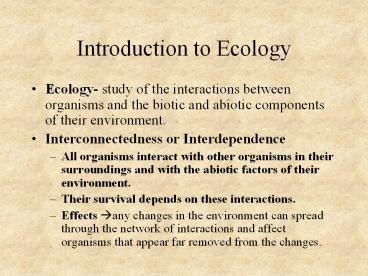Introduction to Ecology PowerPoint PPT Presentation
1 / 14
Title: Introduction to Ecology
1
Introduction to Ecology
- Ecology- study of the interactions between
organisms and the biotic and abiotic components
of their environment. - Interconnectedness or Interdependence
- All organisms interact with other organisms in
their surroundings and with the abiotic factors
of their environment. - Their survival depends on these interactions.
- Effects ?any changes in the environment can
spread through the network of interactions and
affect organisms that appear far removed from the
changes.
2
Levels of Organization
- Ecology is organized into five levels
- Organism? Population? Community? Ecosystem?
Biosphere
3
Ecosystem Components
- Biotic- living components
- Six kingdoms
- Eubacteria
- Archaebacteria
- Protista
- Fungi
- Plantae
- Animalia
4
Ecosystem Components
- Abiotic- nonliving factors
- Temperature
- Humidity
- pH
- Salinity
- Oxygen concentration
- Amount of sunlight
- Availability of nitrogen
- Precipitation (rainfall)
5
Niche
- Habitat- the place where an organism lives
- Niche- the specific role of a species within its
environment - Includes
- (1) range of conditions that the species can
tolerate - (2) the resources it uses
- (3) the method by which it obtains resources
- (4) the number of offspring it has
- (5) its time of reproduction
- (6) all other interactions within its environment
6
Energy Transfer
- Flow of Energy
- Sun? Autotrophs? Primary consumer? Secondary
consumer? Tertiary consumer - Producer (Autotroph)
- Example
- Plants
- some Protists
- some Bacteria
7
Energy Transfer
- Most producers are Photosynthetic
- Terrestrial ecosystems, plants are the major
producers. - Aquatic ecosystems, photosynthetic protists and
bacteria are the major producers - Some bacteria are Chemosynthetic
- Uses inorganic molecules, like sulfur dioxide, to
produce carbohydrates.
8
Energy Transfer
- Consumers
- All Animals, most Protists, all Fungi, and many
Bacteria - Types
- Herbivores
- Carnivores
- Omnivores
- Detritivores- consumers that feed on dead
organisms or animal waste. - Example turkey vulture, many bacteria, fungi
- Decomposers, bacteria and fungi, are detritivores
- Break down complex molecules into simpler
molecules - Release nutrients back into the environment.
9
Energy Transfer
- Trophic level- an organisms position in a
sequence of energy tranfers. - Food chain
- Food web
- 10 of the energy of a given trophic level is
passed on to the next trophic level.
10
Ecosystem Recycling
- The Water Cycle
- Movement of water is between these various
reservoirs - Ocean, lakes, rivers, streams
- Atmosphere
- Groundwater
- Three important processes
- Evaporation
- Transpiration
- Precipitation
11
Ecosystem Recycling
- Carbon Cycle
- Photosynthesis and cellular respiration form the
basis of this cycle - Carbon exists in the atmosphere as CO2
- Sources of CO2
- Cellular respiration, combustion, decomposition
12
Ecosystem Recycling
- Nitrogen cycle
- Recycling nitrogen
- Ammonification- decomposers break down proteins,
nucleic acids (DNA), urine, and dung, to
ammonium. - Nitrification- soil bacteria take up ammonium and
oxide it into nitr ite and nitrates - Plants use nitrates to form amino acids
- Denitrification- anaerobic bacteria break down
nitrates and release nitrogen gas into the
atmosphere
13
Ecosystem Recycling
- Nitrogen cycle
- Importance of nitrogen
- Needed to make proteins and nucleic acids
- Nitrogen gas (N2) makes up 78 of the atmosphere
- Plants can utilize nitrogen in the form of
nitrates (NO3) and Ammonium (NH4) - Nitrogen fixation N2 to NH4
- Nitrogen-fixing bacteria
- Mutualistic relationship between bacteria and
plants - Plants supple carbohydrates
- Bacteria produce usable nitrogen
- Other bacteria convert ammonium to nitrates
- Animals get nitrogen by eating plants or other
animals
14
(No Transcript)

